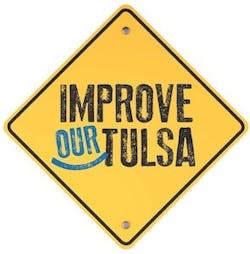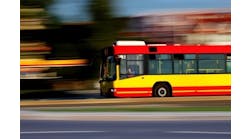The city of Tulsa, Oklahoma, has a transportation vision for its commuters—one that includes bus rapid transit (BRT). The first leg of the service, which will run along Peoria Avenue, broke ground this past January, and is expected to launch in late November.
Funded through a combination of two self-tax systems called, respectively, Improve Our Tulsa and Vision Tulsa, the Peoria BRT line will run north-south, while a later route, the Route 66 line, will run east-west.
“One of the hallmarks of this service is that it will be much more frequent and provide a longer service day,” said Ted Rieck, AICP, general manager of Tulsa Transit, which will operate the system. The service will run seven days a week, Rieck added, as opposed to Tulsa’s typical bus service, which runs six days a week and has shorter service hours. The BRT will feature nine new vehicles and operate from 5:30 a.m. to 10 p.m. with a 15-minute frequency, rather than the traditional bus service’s 45-minute frequency.
“That level of service will be new to our area. It will open up people’s eyes to transit,” Rieck said. “And it is being paid for by a dedicated special tax.”
Vision Tulsa
Tulsa County residents voted in April 2016 to renew Vision Tulsa, a 0.6% tax package that is an extension of the original Vision 2025 initiative voters passed in 2003. HNTB Corp. and Tulsa-based Cyntergy were hired to plan and design the BRT system, said HNTB project manager Brian Comer, AICP.
The BRT buses will be compressed natural gas vehicles and branded as the AERO system, a nod to Tulsa’s aerospace and transportation industry, Comer added. The AERO logo includes art deco elements, also a nod to Tulsa’s downtown art deco architecture. The Peoria line will have about 28 station pairs, mostly across the street from each other. There will be standard stations and “constrained” stations, where the footprint of the station is smaller.
Standard BRT stations will have enhanced amenities including benches, litter receptacles, and vertical markers with real-time arrival signs that will let patrons know when the buses are due to arrive. They also will accommodate a shelter and bicycle amenities.
“This corridor, particularly in the urban areas, has limited right-of-way,” Comer said. A constrained station can fit into a tighter footprint “where we can’t fit a full station with a shelter.”
HNTB has used constrained stations in other BRT systems it has built, and Comer believes the constrained stations will work well on the Tulsa project. “There are a couple of sections of the corridor where buildings come right up to the street,” he said. “In these instances, we want something more than a simple transit pole there.”
The constrained station will still have real-time signs and offer some shelter, he added, while the standard stations will have level boarding: “One of the biggest time sinks is boarding and alighting. Level boarding really speeds up the process and provides better Americans with Disabilities Act compliance. That’s a key consideration for the BRT vehicle.”
Other features of the system will be on-board Wi-Fi and, eventually, priority traffic signaling for the AERO buses.
“We want to put fiber optic in the Peoria and Route 66 lines,” Rieck said. “That will allow us to implement [traffic] signal priority [for BRT vehicles].” That funding will likely come from a technology corridor grant, he added.
HNTB is working with city of Tulsa leaders on these smart corridor improvements, which also will include features such as closed-circuit TVs for traffic operations and ADA improvements, including audible signals at crosswalks, said Eric Strack, P.E., ENV SP, project engineer for HNTB and the engineer of record.
Tulsa Transit is also implementing another technology feature, an app, that will allow transit riders to locate where the buses are in real time “so they feel more comfortable where the bus is, and when it is getting near them,” said Liann Alfaro, Tulsa Transit planning and marketing director. “They also will be able to plan their trips through the app.”
“We’ve revised all of our back-end technology to support this,” Rieck said. “We think this will be a game changer and will attract a new audience.”
The BRT is considered such an important transit opportunity for Tulsa that the project was moved up from its original timeline, Comer said: “The Peoria corridor was originally to open in 2021. It was moved up because it is such a priority for the community.”
Likewise, the shorter Route 66 east-west corridor will now begin earlier. “The planning of that will start this year,” Comer added.
Attracting transit riders
One goal of the BRT system will be to attract more Tulsans to transit, Rieck said.
“When you have a service operating every 15 to 20 minutes, that becomes a real viable option for people,” he said. “We hope it attracts riders who have a disposition to ride the service but don’t because they feel traditional transit is too slow. With the AERO system, they’ll see what service can look like, and by having a showcase, we can elevate people’s expectations, and they will want more of it.”
It is one reason Tulsa is banking on BRT on the 18-mile stretch of Peoria Avenue from 54th Street North to 81st Street South.
One in seven Tulsa residents live within a 10-minute walk of the corridor, and one-fifth of Tulsa’s jobs are within a 10-minute walk of Peoria Avenue, city studies have shown. The Peoria corridor carries more passengers than any other existing transit route in the city, and the corridor was the top transit priority in the 2010 Tulsa Comprehensive Plan, PlaniTulsa.
The BRT investment is $20 million, but Rieck considers that money well spent.
“Oklahoma City is putting in a streetcar and spent more per mile on that than Tulsa’s BRT project,” he said.
The funding for BRT was part of a transportation package that includes roads and bridges, Rieck said. “We’ve been eager to get it implemented. We’ve been trying to get this done for five or six years.” And while Tulsa commuters saw BRT service begin this summer, Tulsa Transit has also been enhancing other transit.
“We are in the process of implementing a complete system redesign for a conventional bus system to better feed BRT,” Rieck said. “The BRT can be a spine and move north-south, and will eventually have good east-west connections.”
The two BRT lines, the Peoria and Route 66 segments, will eventually connect at 11th Street and Peoria Avenue, said Comer. “Both routes will connect into the Denver Avenue station, which is [Tulsa Transit’s] hub for most transit,” he said. That station also is near Cox Business Center, Tulsa’s convention center.
Tulsa Mayor G.T. Bynum, at the BRT ground-breaking ceremony, noted BRT is popular in other countries, but is relatively rare in the U.S. “When we open, we will be one of only 12 cities to have this in the country,” he said. “By having this, what we are going to do is open up the city in a way that it’s never been accessible to people before.”
Tulsa residents will have greater access to jobs, job opportunities, educational opportunities, and health care opportunities, Bynum added—all because the citizens of Tulsa recognized the benefit of BRT, so much so that in 2016, “citizens of Tulsa approved the first public transit-dedicated tax in Oklahoma.”
More than commuter service
Tulsa’s BRT has social and economic aspects to it, as well, Rieck said. “The northern part of the line is more economically depressed and a food desert,” Rieck said. “This will allow people to have more food options and have more health care options.”
Tulsa also has a new downtown development director, and efforts are being made to better link transit and downtown. “What I see is we will be able to connect key entertainment areas downtown,” Rieck said. “I can see this being able to string these pearls together, and for the downtown worker or resident to not need a car to get to these venues. It makes the downtown more attractive.” Downtown employees will be able to go to these areas on their lunch hour, without getting into their cars. “We think it will support downtown development and be an attraction to visitors who are here for conventions.”
Additionally, millennials also are very attracted to public transit and more urban areas, such as Tulsa’s downtown.
“The direction I see transportation going is shifting away from owning the asset model, to the rideshare model, and transit can sit in that,” Rieck said. “BRT can do a lot of things, and if it showcases what transit can actually do, I think people will be surprised and want more of this kind of service. The future looks bright if we can get the public involved in that.”



